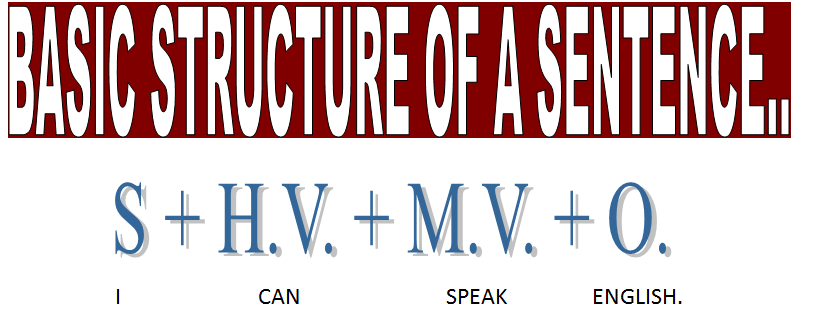In this tutorial you will learn about the Structure of different types of sentences and its application with practical example.
In this tutorial, we will learn about Structure of different types of sentences
Prerequisites
Before starting with this tutorial we assume that you are best aware of the following topics:
- Nouns.
- Pronouns.
- Verbs.
- Adjectives.
- Adverbs.
- Prepositions.
- Conjunctions.
- Interjections.
Let us recall what we have learnt in Lesson- 2 about a sentence and its types.
There are four types of sentences on the basis of their meaning.
Declarative (Positive and negative)
Interrogative (yes/no type questions and W-H questions)
Imperative (command, request and suggestion)
Exclamatory (expressions)
These all types are sentence follow different patterns of using parts of sentences.
Let us see some examples of each type of sentences.
- I can speak English. (Subject-I, Helping verb-can, Main verb-speak and English-object)
- I cannot speak English. (Subject, Helping verb+not, Main verb, and Object)
- Can I speak English? (Helping verb, Subject, Main verb and Object)
- Can I not speak English? (Helping verb, Subject, Not, Main verb and Object)
- How can I speak English? (W-H words, Helping verb, Subject, Main verb and Object)
- Please speak in English only. (Request, Main verb and object)
- What a fluent English speaker you are! (expression, Object, Subject and Helping verb)
Above, all sentences using all the parts of sentences at different places and giving different meaning.
Now, let us see their structures with examples:
(S – subject, H.V. – helping verb, M.V. – main verb and O – object).
- Positive sentence:
| S + H.V. + M.V. + O. |
I CAN SPEAK ENGLISH.
- Negative sentence:
| S + H.V. N’T + M.V. + O. |
I CAN’T SPEAK ENGLISH.
- Interrogative sentence:
| H.V. + S + M.V. + O. ? |
CAN I SPEAK ENGLISH?
- Interrogative negative sentence:
| H.V.N’ + S + M.V. + O. ? |
CAN’T I SPEAK ENGLISH?
- W-H question sentence:
| W-H + H.V. + S + M.V. + O. ? |
HOW CAN I SPEAK ENGLISH?
- Imperative sentence: This type of sentences do not use any Subject or Helping Verb.
| M.V. + O. |
STOP THE CAR.
But, in negative form of imperative sentences, ‘Don’t’ as a helping verb is used.
| DON’T + M.V. + O. |
DON’T TELL A LIE.
- Exclamatory sentence:
| INTERJECTION ! + WHAT/HOW + O. + S + H.V. ! |
WOW ! WHAT A CAR YOU HAVE!
So, now you must have understood the placement of a subject, helping verb, main verb and an object.

From lesson number 1st to 4th, we have learnt theoretical grammar in which we have seen definitions, types and examples. In practical English (we us in speaking), these things are not asked by anyone, but, we should have knowledge of them. In competitive exams, they ask you a deep knowledge of English grammar including both theoretical and practical.
So let us begin theoretical portion of English grammar….

